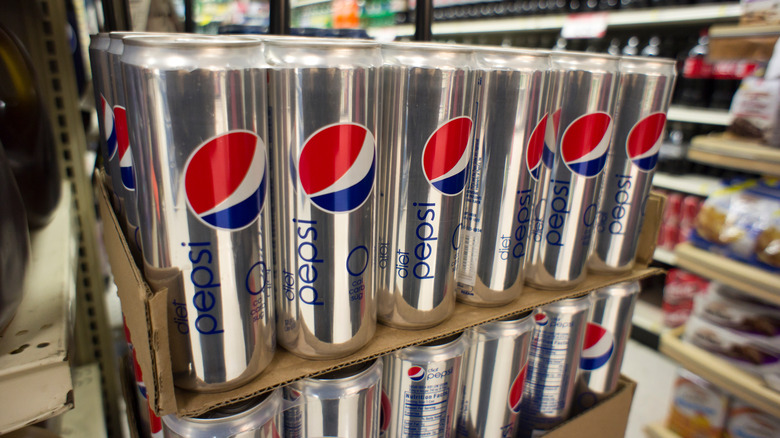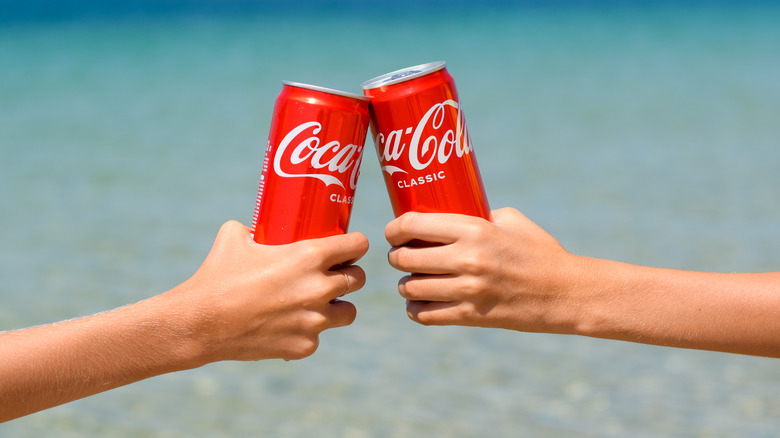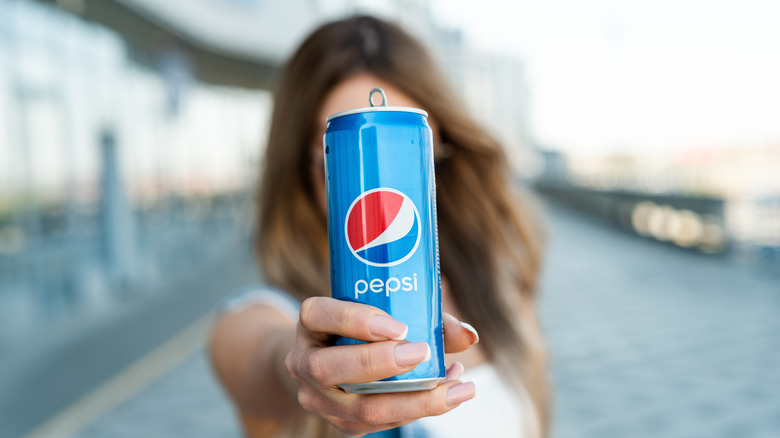Why Your Soda Cans Keep Getting Smaller
Is the whole world shrinking? Probably not, but many packaged foods are trimming their girth. And that includes your soda cans. You may be increasingly noticing that many of your favorite soda brands are now selling taller, slimmer cans than before. And while many consumers might assume they are getting less bang for their buck — as is the case with a number of products that have fallen victim to the "shrinkflation" trend — fortunately, these newly designed soda cans lining supermarket shelves are an exception. The newer cans may appear smaller, but they hold the same amount of soda as their chunkier predecessors. A standard can of drum-shaped soda holds 12 ounces, as does the same carbonated drink housed inside the slimmer can. There's just a reconfiguration of the dimensions, crafted to hold an identical volume with a more appealing presentation.
That change may seem pointless to consumers unswayed by visual appeal over practicality – but studies have confirmed that lovers of soda and sparkling waters such as Sanpellegrino embrace the more sophisticated look of the redesigned cans, and that the change has indeed had an impact on some consumers' shopping choices. It's also an easy way for manufacturers to freshen things up without changing beloved formulas, or having to introduce new versions of all-time favorites. But consumer perception isn't the only thing at play – thinner cans also save money for the manufacturer.
Slimmer soda cans save on costs across the board
With rising transportation costs worldwide, even the smallest adjustments can save companies big bucks in the long run. When it comes to soda, it's easier to accommodate 12-ounce cans that are slimmer and taller, as they fit more compactly in warehouses, on shipping pallets, and in available truck and barge spaces, all of which means lower costs. The savings apply to transporting soda and other drink cans across both long and short distances.
The same applies to retail shelf space for 8- or 12-packs as well as single-serve sodas in refrigerated display cases. Slimmer cans consume less space, allowing for more quantity and readily available access as consumers and food delivery services such as Instacart clean out aisles throughout the day and night.
However, it's worth noting that the cost of converting manufacturing and production facilities to accommodate new can sizes is considerable up front, especially if only select products will feature the slimmer versions. Niche, craft, and small-batch soda and beer companies may hesitate to make the investment on what could be only a passing fad.
Aesthetic appeal affects purchasing decisions
The slim can phenomenon isn't only about financial bottom lines. The newer can styles are different, which draws attention in the sea of sodas vying for market dominance. The taller height sets these cans apart visually from their stodgier counterparts that have yet to make the conversion. That alone could cause a consumer to stop and consider a new thirst-quenching alternative.
But there's more at play than just the attention grab. Somehow, the new soda can dimensions have garnered positive perceptions linked to a more upscale, exotic, youthful, or even healthier lifestyle. Part of this could be attributed to the release of health-conscious beverages in the thinner cans, including low-carb beers, energy drinks, hard seltzers, and natural fizzy waters with little or no additives. Brands embracing this new perception include major soda companies as well as Starbucks, White Claw, Truly, Anheuser-Busch, Heineken, and many more.
It's worth noting this is not the first time taller, thinner soda cans have hit the market. Pepsi debuted one during fashion week in 2011. However, it was squashed thanks to a controversial marketing campaign relating the "taller, sassier" cans to "beautiful" and "confident women." The campaign drew widespread criticism for equating skinniness with beauty and self-esteem. Marketing of the company's newest release of slim cans self-corrects by using terms such as "sleek" rather than "skinny." And because the trend has been growing outside of soda, this time around the slimmer cans are much more well-received.



